Pruning is fun when the pruner is confident and knowledgeable. Plant health is the main consideration for selecting a thinning and renewal pruning technique. The technique can be modified, depending on the growth habit of individual species.
Most evergreens maintain their foliage throughout the year. Evergreens fall into two broad categories, narrowleaf and broadleaf species. Narrowleaf conifers include pine, spruce, fir, and hemlock; other narrowleaf evergreens include yew, juniper, arborvitae, and false cypress. Pine, spruce, and fir grow only in the spring and early summer and do not need to be pruned each year, whereas arborvitae, juniper, yew, and hemlock continue to grow throughout the season and must be pruned annually.
Broadleaf evergreens include rhododendron, Japanese andromeda, holly, and mountain laurel. They are normally pruned every two or three years, depending on their growth rate.
Evergreens have the potential for living almost indefinitely if soil, exposure, moisture, fertility, and pruning are favorable, so careful evaluation of the planting site is important. Don’t plant evergreen trees in foundation plantings. Minimize yearly pruning by selecting evergreens based on their mature height and width. Soil type will impact moisture availability and susceptibility to winter injury. Desiccation of foliage is very common when broadleaf evergreens are planted on windy sites in full sun.
Time of Pruning
Needle evergreens are best pruned in early spring after the ground has thawed and no later than June 15th.
Pines are pruned in late spring to avoid excessive bleeding. Spring pruning is best for correcting structural problems, since wound healing is most rapid at this time. Late summer and fall pruning may cause sun scald symptoms (burning of foliage) that appear in late winter. New growth stimulated by summer pruning may also die back from the first hard frost in September. Broadleaf evergreens are best pruned in the spring following bloom. If bloom is not a consideration, pruning can be done in early spring.
Pruning Tools
Hand shears and loppers are recommended for pruning all evergreens. A fine-toothed saw and pole pruner are effective on evergreen trees.
There are two styles of hand shears: bypass (scissor action) and anvil (one blunt blade). The scissor style is more expensive but makes cleaner, closer cuts. The anvil type will move faster through a shrub. For that reason alone, it is the tool of choice.
Lopping shears have long handles and are operated with both hands. They are generally used for correcting and improving the branch structure.
An apple saw (8 points/inch) is most effective in pruning large branches.
Pole pruners are effective for reaching the tops of conifer trees and tall shrubs. The cutter is on a pole being operated by pulling a handle or rope. Poles can be telescoping or fit together in sections. Fiberglass or plastic poles are best because they are lightweight and safer around electric wires.
Pruning Guidelines
Do not try to rectify years of neglect in one season. Prune evergreens less severely than deciduous trees and shrubs because of their slower growth rate.
Yews, hemlock, and arborvitae will produce growth from dormant buds on old wood. They can be pruned harder than juniper, spruce, pine, and fir that usually do not form buds on old wood. Light, periodic pruning is a better long-term approach to maintain plant size and form.
Pruning Technique
“Shearing” evergreens by trimming the outer edges of branches to give the plant a desired shape is a common pruning technique with many disadvantages. Shearing:
- makes it difficult to control plant size.
- causes loss of natural shape and individuality.
- removes flowers.
- prevents sunlight from reaching the center of the shrub, resulting in a “dead zone” and reduction of total leaf surface area. (See Figure 1.)
- removes new shoot growth while maintaining less productive older wood.
- encourages multiple leaders on upright species, resulting in lopsided plants.
- retains vertical growth and large sprawling branches with narrow V-crotches.These branches are prone to ice and snow damage.
- excessive surface growth creates stagnant air in the center of the shrub and a desirable environment for red spider mites and mealybugs
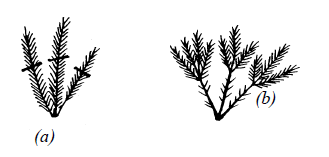
On the other hand, using a thinning and renewal pruning technique will promote internal growth, reduce winter injury and produce a natural form that compliments informal landscape plantings. Thinning cuts remove more growth, especially old wood, reducing the shrub’s total size without changing its natural appearance.
In thinning, work with the natural growth habit of individual species. Some evergreens are spreading types while others are more upright or pyramidal. Evaluate each situation and form a strategy for achieving your goals. Major changes in branch structure may require many years of pruning.
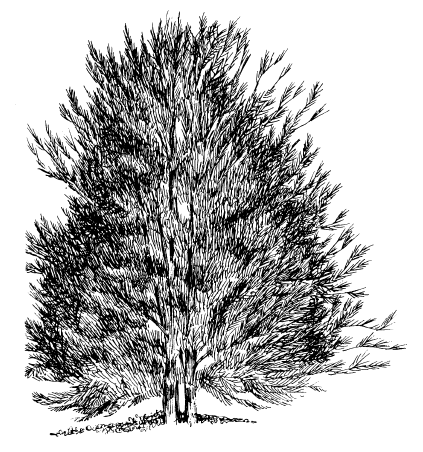
Pruning Yews (Taxus species)
Taxus come in several different forms. There is no difference among them in the type of growth removed or procedures followed in controlling shrub size. The one exception is with an upright yew, Taxus cuspidata ‘Capitata’, where multiple leaders are reduced to one “central” leader. (See Figures 2 and 3.)
The first step in controlling the size of an upright yew is to establish a “perimeter line” which identifies where its surface will be located.
Always maintain the base of the shrub wider than the top. Make no “heading” (surface) cuts on the shrub perimeter. Instead, to maintain the perimeter line, remove the longest branches at a node where one branch meets another, making a flush cut. Remove branches that are growing sideways or towards the center of the shrub. Pruning cuts made in the center of the shrub will stimulate latent buds to break, which are essential in the renewal process.
Remove club-like growth resulting from repeated shearing. Shoots that extend to the perimeter are allowed to remain unless there is excessive growth and duplication of branches.
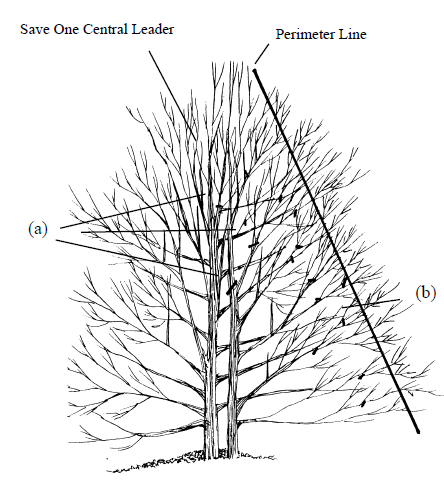
(a) Remove multiple leaders entirely or gradually. (b) Remove all shoots that extend past the perimeter line by making cuts in the interior of the shrub.
Select one strong leader located in the center of the shrub, and either remove all other vertical shoots entirely, or remove them gradually as new growth fills in behind the leader. This will prevent a lopsided shrub with most of the growth on one side.
The thinning process is the same with all evergreen shrubs. Heavy spring pruning may require some light touch-up pruning during the summer months. Remove one of every three or four shoots.(See Figure 4.)
Arborvitae (Thuja species)
Arborvitae shrubs are described as having a columnar, pyramidal or globose shape. They can be pruned as severely as Taxus if not located in the shade. New growth can be encouraged to start farther back on older wood.
Arborvitae continually produce vertical shoots that are inclined to bend over under the weight of snow and ice. The columnar or pyramidal arborvitae should have no more than three leaders. It may be necessary to gradually reduce their size before final elimination. Leaders may be tied together to provide added strength.
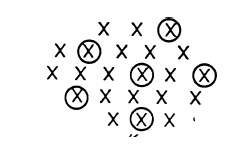
When pruning arborvitae remove only vertical growth inside the perimeter line. No horizontal growth is removed. This method prevents die-back of surface needles and allows sunlight to penetrate the interior of the shrub preventing a “dead zone” and environment that encourages spider mite. (See Figure 5.)
Juniper (Juniperus species)
Junipers are the toughest of all evergreens. Their shape can vary as spreading, upright, pyramidal or creeping. Dwarf, slow-growing or ground cover types require little pruning in comparison with the spreading forms such as “Juniperus chinesis”, “Pfitzeriana” and “Hetzii” that require extensive pruning to maintain their form and size.
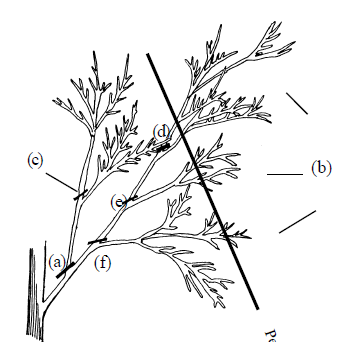
(a) Remove competing leaders. (b) Horizontal shoots are never cut. (c) Vertical shoot. (d), (e), & (f) Select one to cut. (f) Is cut because shoot (c) is behind it and will grow out and fill the space.
Spreading types are often sheared, resulting in the loss of their natural shape. They can be very attractive when branches are pruned in layers. (See Figure 6.)
Pruning involves the use of lopping shears and hand pruners. Remove long and large diameter branches in favor of shorter and smaller diameter ones. (See Figure 7.)
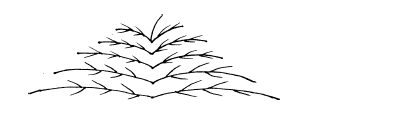
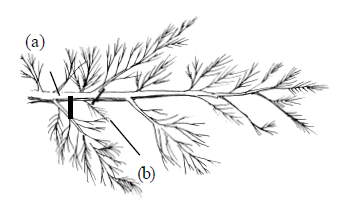
Pine (Pinus species), Spruce (Picea species), Hemlock (Tsuga species)
Although there are dwarf or trailing conifers suitable for foundation plantings, it is common to see trees placed there. In general, trees grow too tall and eventually outgrow their space in the foundation bed.
If pruned properly, the size of pine, spruce, and hemlock can be maintained in one’s lifetime. The only pruning needed in the first 10 years of life is the removal of competing leaders or those lost from insect attack. The central leader is removed when a tree has reached its desired height. This will promote internal branching and greater density. If the height is shortened dramatically (3 or more years’ growth), it may be necessary to train a new leader. (See Figure 8.)
Figure 8.
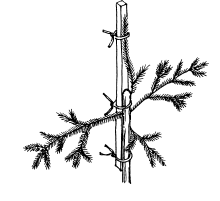
leader by tying a 1” x 1” stake to the cut end of the trunk and a side branch from a whorl to the other end. After one year, the branch (leader) will assume dominance and the stake will be removed to prevent girdling.
Train a new leader by tying a 1” x 1” stake to the cut end of the trunk and a side branch from a whorl to the other end. After one year, the branch (leader) will assume dominance and the stake will be removed to prevent girdling.
Conifers will not tolerate shearing and may die if shorn over a period of years. Removing a portion of the “candle,” as recommended in most pruning literature, is not recommended on tree conifers. It may serve a purpose in training Mugho pine to branch at a young age, but should be considered a shearing practice that contributes to the demise of mature conifers. (See Figure 9.)
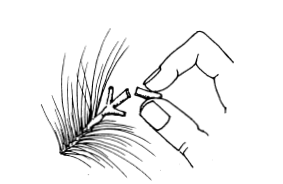
It is important periodically to remove a few large limbs in favor of smaller diameter branches because large limbs have fewer needles. Evergreen screens often stop functioning due to loss of lower branches and needle density. Follow the same pruning principles, as explained earlier, removing only branches that have grown past the established perimeter line. Remove branches that are crooked, duplicating, touching, and growing sidewards or vertically. Cut only at a whorl or node. Remaining branches should grow in a straight direction.
Rhododendron and Azalea - (Rhododendron species), Mountain Laurel (Kalmia latifolia)
Leucothoe (Leucothoe fontanesiana), Japanese Pieris (Pieris japonica)
Broadleaf evergreens can withstand fairly heavy renewal pruning under favorable growing conditions. They enjoy partial shade and protection from wind. Plant them in well-drained soils containing ample organic matter to retain moisture.
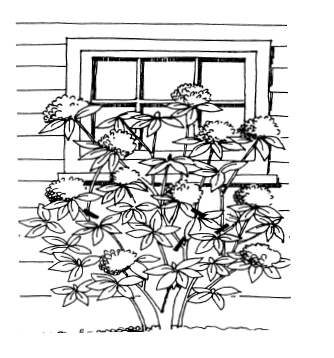
A light, periodic pruning regime is a good approach for maintaining size and form. Occasionally, plants will have old leggy stems that should be removed at ground level, leaving behind more vigorous understory
removed by cutting flush toshoots. (See Fig. 10)
Thin broadleaf evergreens by cutting stems at their point of origin. Thinning is often done to create “depth perception.” Pruning cuts made within the shrub perimeter will encourage development of renewal branches. (See Figure 11.)
Use fingers to snap out faded flower trusses. Be careful not to break off leaf buds that may have started to form beneath them. This practice prevents seed formation, which drains nutrients needed for new shoot growth and flower bud formation.
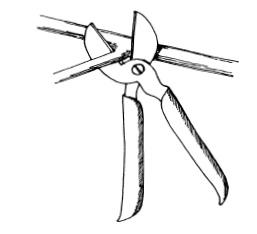
Close cutting will accelerate the healing process and prevent evergreens by cutting dieback. Do not twist the shears
while cutting.
------------------------------
Original fact sheet by David Seavey, UNH Extension Educator, Agricultural Resources, revised March 2001
Illustrations by Karen Holman, UNH Extension Master Gardener.
Do you love learning about stuff like this?
SUBSCRIBE TO Granite State Gardening newsletter
Got questions? The UNH Extension Yard and Garden Infoline offers practical help finding answers for your yard and garden questions.
Call toll free at 1-877-398-4769, Monday to Friday, 9 a.m. to 2 p.m., or fill out webform.

